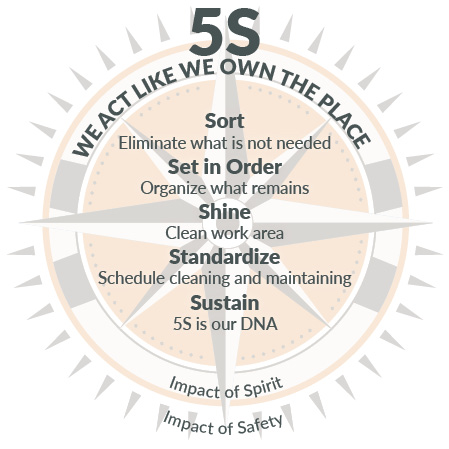Beyond Spring Cleaning
By Scott Ellis, Ed.D.
March 20, 2024

I like order. I enjoy building systems to create and maintain order. I understand the need for routine maintenance, but I’ve always seen it as drudgery. I also hate repeating a job because a good system fails for lack of follow-through. Spring cleaning is one of these jobs in which enthusiastic effort is expended with high hopes that the cleaner, more spacious, and functional space will last. When disorder returns, that enthusiasm may sour to cynicism and discourage involvement the following spring.
A system that has been helpful to many is 5S. Having said that, I imagine many responding that their 5S efforts have not been maintained for lasting improvement. In fact, some have become cynical and resistant to 5S. Perhaps the system failed because the person assigned to lead the initiative moved on, or it’s due to disruption in the market. Even in the best conditions, considerable effort is required to overcome human nature and entropy. Most often, I see the failure as the natural outcome of completing only three of the five components of 5S. The most visible results of 5S are in these three activities: sort, set in order,and shine. The remaining two agreements are more difficult because they require us to standardize the best practices adopted as policy. Then, we must develop discipline as a team and an organization to sustain those practices as a part of our culture.
Very few would contest the benefits of a more ordered work environment. Those who complete and maintain all 5S pillars can easily track gains in safety, morale, space, and productivity. Those companies have designated and equipped staff to focus on continuous improvement as facilitators rather than as compliance managers. They also share a common application of 5S beyond machine centers, starting with maintenance, prepress, and common areas.
I believe the key is to relentlessly focus one year out. Ask yourself, “How will this system be understood, owned, and continued by the people closest to the process?” I concentrate during the planning of 5S implementation and, at every step of the project, on the agreements. I ask, “How can this be standardized so team members see the value and do the right thing when no one is looking?” I also explore what must be done to equip and encourage everyone—from the CEO to the new hire—to support and maintain these practices over time.
You’d like an example? This past year, Ty Pickle received his third requisition for tooling racks in a six-month period. He visited the storage area and found tools stacked and crowded into racks, and he saw no way to determine their ages or dates of use. Consequently, Ty mandated a purge of all tooling that had not been used in 24 months. The prepress staff jumped at the chance to free up space. The customer service manager provided a list of tooling that met the requirements, and the tools were identified and quarantined. Then came the pushback. Sales was given a list of purge-worthy tools. They were concerned about parting with any tooling for fear of inconveniencing a customer. They also resisted the mountain of paperwork involved in determining the disposition for each of the tools. Once this was solved, it was discovered that while all print plates were tied to a particular customer, a number of cutting dies were used with multiple customers, which encouraged even more caution. In short, the project died prematurely, and the quarantined tools are still in an old trailer on the yard.
At a nearby competitor, owner Phil LaThroo also visited the tooling storage area and issued a similar mandate. The primary difference was that Phil focused on the activities and the agreements to complete all 5S pillars. He assembled a cross-functional team, including representatives of continuous improvement, prepress, customer service, sales, and information technology (IT). The system they presented to Phil was productive and sustainable. Their new system included:
- A report built by IT and customer service showing print plates, cutting dies, customers associated with each, date last used, and number of impressions. In this way, they are aware of the risks to customers. They added to their policy that tools be replaced automatically at 900,000 impressions.
- They changed the criteria to 18 months.
- The report is produced monthly. This allows prepress to quarantine a small number of tools per month and better manage their space.
- Sales constructed a customer letter regarding tool disposition. IT used a macro to populate the letter with the pertinent data from the report. Most salespeople now use this letter to spur an in-person conversation with the customer about the item that has not run in 18 months—and about any other opportunity.
- A time limit of 30 days was added to the company’s tooling policy so no tool purgatory is required.
- Each tooling storage location, including line-side storage, has been assigned a bin location in the bar-coded system. This reduces time in locating materials as needed.
Phil’s company has noted savings of space, overtime pay, speed of tooling to the machine, and face-to-face meetings with customers. An unforeseen improvement was also discovered. Their tooling repair cost has been reduced by 30%. The die making supplier attributed this to reduced damage in crowded storage conditions.
Culture change is always a struggle against human nature and entropy. Lasting change requires unrelenting focus on the factors that will help team members standardize best practices
and sustain their use. If we know why it is required and we know how it improves our work, we will be much more likely to do the right thing when no one is looking.

Scott Ellis, Ed.D., delivers training, coaching, and resources that develop the ability to eliminate obstacles and sustain more effective and profitable results. He recently published Dammit: Learning Judgment Through Experience. His books and process improvement resources are available at workingwell.bz. AICC members enjoy a 20% discount
with code AICC21.
Sidebar: Ready to Learn More?
Take these free online courses: 5S for Newbies and Maintenance Department 5S. Learning.AICCbox.org

